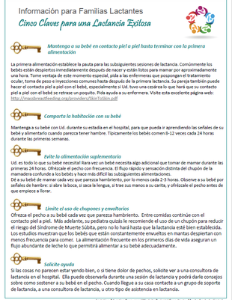If you are reading this, it’s probably because you are considering breastfeeding your baby or have already begun. Congratulations! Breastfeeding is the best form of nutrition for most infants.
Handouts
& Videos
(English)
Handouts
& Videos
(Spanish)
Links to Resources
in many other languages

FAQs
We can help you breastfeed.
Even though breast is best, breastfeeding may not be as easy as it looks. Erie Family Health Centers has providers who can help you get started and support you along the way. We have information on:
- the benefits of breastfeeding
- what to expect immediately after you have your baby in the hospital,
- how to keep up the breastfeeding once you get home with your baby
- how to use a pump and store milk for up to a year
- breastfeeding supplies you might find useful
- common problems of breastfeeding

At our health centers we can provide a variety of breastfeeding support by phone, telehealth appointments, or in-person visits. We have certified lactation consultants on staff who can address complicated breastfeeding issues.
English Breastfeeding Video Library
ABCs of Breastfeeding (firstdroplets.com)
Attachment
ABCs of Breastfeeding (firstdroplets.com)
Breastmilk Production
ABCs of Breastfeeding (firstdroplets.com)
Calories
Breastfeeding Quick Start
Spanish Breastfeeding Video Library
ABC de la lactancia materna (es.firstdroplets.com)
Apego
ABC de la lactancia materna (es.firstdroplets.com)
Producción de leche materna
ABC de la lactancia materna (es.firstdroplets.com)
Calorías
Lactancia natural guía rápida (Spanish)
Breastfeeding Resources in Many Languages
Global Health Media (globalhealthmedia.org/videos) is a wonderful resource for breastfeeding videos in multiple languages. Topics include attaching, breastfeeding in the first few hours, skin to skin carrying, and more.
At LactationTraining.com, you can download handouts about breastfeeding in multiple languages, including Spanish, Chinese, Arabic, Vietnamese, and Polish.
La Leche League International (llli.org/resources) has articles in many languages about breastfeeding. Just select your language from the "find your language" link at the top of the page.
Firsdroplets.com is an organization dedicated towards encouraging parents to take advantage of effective breastfeeding techniques to prevent common challenges. There are videos in English and Spanish.
NorthShore University HealthSystem offers comprehensive breastfeeding resources for you and your baby.
Though breastfeeding is considered a natural way to feed a newborn, it may not always come naturally. Northwestern Medicine's Breastfeeding Support page has guides that can help you learn how to breastfeed successfully.
IABLE (lacted.org/videos) is a nonprofit organization whose mission is to optimize the promotion and support of breastfeeding for families in the outpatient sector. This organization has additional video resources in English.
Frequently Asked Questions
Please reach out to your primary care provider if you are experiencing trouble with breastfeeding. Don't delay! You may call 312.666.3494 to be connect with a nurse, or send a message through MyChart.
You can choose and/or alternate from the following positions. No matter what position you choose, your baby's face and chest should be turned to face your breast and body. Good positioning is key to preventing nursing problems.
Laid Back
In this position, the mother lies back at a 45 degree angle (or more) and the baby is placed on her chest tummy to tummy. This is a particularly helpful position for newborns as it helps them to latch with less effort. It can also be useful after a cesarean birth. Watch the video from Natural Breastfeeding to see how it's done.
Football Hold
Place 1-2 pillows vertically behind you. Place enough pillows at your side to support your arm and baby's body at breast level. Position the baby at your side with the buttocks tucked in under the bend of your arm. Support his lower head and neck with your hand and his back with your lower arm. Football hold is ideal in the early stages of nursing for the cesarean mom, the small or preterm baby and for the mother with large breasts.
Cross-Cradle Hold
Position the baby on his side facing you as in the cradle-hold but hold him with the opposite arm so that your hand can support the back of his head and neck. Hold the breast with your free hand in the "c" hold. After he has latched on, you may want to switch your arms back to the cradle hold. The cross-cuddle hold and the football hold positions give excellent control of the baby's head when bringing the baby to your breast.
Cradle Hold
Place a pillow in your lap. Turn your baby on his side so that his whole body is turned in facing yours. His head will be in the bend of your arm and his lower arm will be around your body.
Side Lying Position
Mother and baby lie on their sides, facing each other. Baby's head should be level with the breast. Place a pillow under your head and neck and behind your back to add support and comfort. Place a rolled receiving blanket or towel behind the baby to keep him from rolling onto his back. This position is ideal for night nursing.
Your baby's ear, shoulder and hip should be in a straight line.
When your baby starts to suck you may feel some tenderness. Within a minute, it should be painless and feel like a tug. If you feel discomfort throughout the feeding, take the baby off the breast by breaking the seal with your finger and begin latching on again.
The following steps will help your baby latch on properly:
- Support your breast with your four fingers below the breast and your thumb on top, without touching the areola - the "C-hold".
- With your nipple, stroke the baby's lower lip until he opens his mouth wide (like a yawn). This may take a number of attempts.
- As soon as the baby opens wide, quickly bring the baby in close to the breast. Do not lean towards the baby or push your breast into the baby's mouth.
- The baby should have the entire nipple and at least some of the areola in his mouth.
- The baby can be held close enough so his nose touches your breast. Babies have broad noses and can breathe out the sides. The baby will pull her head away if he cannot breathe. It is not necessary to push down on your breast.
- Once latched on, the baby's lips are flanged out and relaxed. If either top or bottom lip are rolled in, it may be uncomfortable for the mother.
- Your baby should have a rhythmic suck and swallowing should be heard on a regular basis.
The first 1-2 days, your baby may be very sleepy and you may need to wake your baby to nurse. Feedings may be 2-5 hours apart during this time. Attempt frequently to help your baby learn to breastfeed.
Breastfeeding may not always be easy, and you can expect to have some discomfort with breast fullness and nipple tenderness, especially when you first start nursing. While other complications may develop—such as engorgement, plugged ducts and mastitis—there are some steps you can take to help ensure proper breast care when nursing:
- Hand express some milk onto the nipple and allow it to air dry after each feeding
- Alternate nursing positions to consistently empty milk ducts
- Avoid using excessive amounts of soap on the breast when showing
- Wear all cotton bras and change breast pads frequently
- Use a small amount of ultra-purified lanolin after feedings and allow nipples to air dry
If you baby does not adequately remove the milk from your breasts, it may lead to breast engorgement. This can cause your breasts to feel hard, painful, hot and appear taut or shiny. Engorgement can make nursing difficult for your baby, and painful for you.
Prevention
- Breastfeed frequently, 8-12 times in 24 hours
- Express your milk when feedings are missed
- Wean your baby gradually
Treatment
- Apply a hot, moist towel or take a hot shower before nursing your baby. Hand express some milk to allow for easier latching.
- Apply cold compresses or cold cabbage leaves prior to nursing if breasts are severely swollen or engorged. Ice as necessary to relieve discomfort and reduce swelling.
- Massage breast before and during breastfeeding and pumping.
- Relax. Try taking deep breaths, listening to music and other techniques to ease discomfort.
- Use a breast pump as necessary to express milk if your baby is having problems latching or if you only nurse on one side per feeding.
Plugged ducts are tender spots or lumps in the breast that occur when milk is unable to flow freely. While a plugged duct may be uncomfortable and painful to the touch, you will generally feel fine otherwise. Symptoms tend to come on gradually and do not include fever.
Prevention
- Empty the breast completely after each feeding. Use a breast pump, as needed.
- Position your baby properly at the breast when nursing.
- Wear a comfortable, properly fitting bra.
- Reduce the amount of pressure on breasts (includes: heavy bags, baby carriers or sleeping on stomach)
- Avoid foods high in saturated fats
Treatment
- Rest
- Moist heat to affected area before feedings
- Massage lump before and after feeding from behind the lump toward the nipple
- Nurse (or pump) often. Remember your baby is more efficient at emptying the breast than a pump.
One of the more serious complications of breast feeding includes a breast infection, otherwise known as mastitis. Mastitis can be caused by an improperly or untreated plugged duct or cracked nipple, as well as from anemia, stress or fatigue. Unlike with a clogged duct, symptoms of a breast infection may come on a suddenly and be more bothersome, including:
- Fatigue and flu-like muscle aches
- Fever above 101
- Headache
- Intense, localized pain
- Red, hot and swollen breast
Treatment
- Talk with your provider and determine if antibiotics are necessary.
- Rest.
- Breastfeed frequently and try to keep breasts as empty as possible. Your baby will not get ill from the milk.
- Try not to skip or delay feedings. Pump frequently if unable to nurse.
- Apply moist compress or soak breast in warm water before feedings. Massage the affected area using a gentle but firm circular motion after warm soaks.
- Wear a support bra that does not cause painful pressure.
- Take Tylenol for fever or discomfort.
Determining the cause of the infection will help to prevent a recurrence, as will proper breast care.
Attempt to breastfeed every 2-3 hours
- Watch for feeding cues such as yawning, stretching, bringing hands to mouth, rooting.
- Position yourself comfortably with the baby raised to the level of your breast rather than stooping your shoulders over the baby.
- Football or cross cradle gives you the best control of the baby’s head
Review Proper Latch-on Techniques
- Baby has a wide mouth, taking in as much of the areola as possible
- Baby’s top and bottom lip are flared
Look for the following signs to know that your baby has breastfed well
- You feel your nipple/areola being pulled and released as the baby sucks
- Listen for swallowing sounds, especially after your milk comes in
- Your breasts will be softer after the feeding, once your milk comes in
- Baby’s mouth will open and shut in a strong gliding jaw movement
If the baby does not nurse well, a supplement of expressed breastmilk or formula may need to be given
- Your pediatric provider will recommend the amount of supplement to be given
- The supplement may be given by any one of the following methods:
- Supplemental nursing system at the breast, or on the finger (finger-feeding)
- Infant feeding bottle
If the baby is not latching effectively, it is recommended that you use a hospital-grade (rental) electric breastpump.
- Pumping stimulates the hormones, which tell your body to produce breastmilk
- Pump for 15-20 minutes following each breastfeeding attempt (8-12 times in 24 hours)
Keep a diary of feedings, wet and dirty diapers (Breastfeeding Diary)
- If your infant is not meeting the recommended guidelines, contact your pediatric provider.
By the third day of life, (from 48 hours old to 72 hours old):
- Your baby nurses 8-12 times in 24 hours.
- Your baby has at least 3-4 wet diapers in 24 hours.
- You can hear your baby swallowing. A swallow sounds like a "sigh". Frequent swallowing is the most reliable sign that the baby is getting milk.
By 4-5 days of life and following, your baby should have 6 or more wet diapers in 24 hours.
- Your breasts are softer after the baby nurses.
- Your baby has at least one bowel movement in 24 hours. The pattern of stooling varies greatly in breastfed babies. Stools are mustard yellow in color and a seedy/cottage cheese consistency.
- Your baby is back to his birth weight by two weeks of age.
Call your pediatric provider if by 3 days of age:
- Your baby is not nursing every 2-3 hours for at least 10-15 minutes.
- Does not have 3-4 urine diapers in 24 hours.
- Has not had one or more bowel movements in 24 hours.
Not all women need pumps. Babies are made to be the most efficient breast pump! But if you expect to be returning to work or school before you are done with breastfeeding it is likely that you will need one. Another reason to use the pump is if you are away from the baby at a feeding time, or if the baby does not nurse well/long enough to empty your breasts completely at a feeding. Generally women don’t need a pump in the first few days of the baby’s life as long as the baby is well and mom and baby are not separated.
Most insurance plans will cover the cost of a breast pump for a first time mom. Some plans limit how often they give out a new pump so it is important to check to see if you are eligible to get it through insurance if you received one in the past. If you are eligible you can request a pump through insurance either directly from their website, or by asking your prenatal provider to order one in the last few weeks of the pregnancy or after the birth. In addition Erie often has pumps that can be handed out to patients at a newborn or postpartum visit once insurance has been checked.
You may request a breast pump with NEB Medical Services here. You are also able to purchase pumps directly from the store without using insurance.
The most efficient type of pump is the electric pump that empties both breasts at the same time.
Most providers who care for pregnant patients and newborn babies are able to help you with breastfeeding questions. If the problem is more complicated they know whom to ask for help. We have lots of staff at Erie who are trained to assist breastfeeding patients, including lactation consultants (IBCLCs), WIC, case management, health educators, nurses and others. Each Erie site has identified who these people are. When you call for help with such problems or come in for an appointment we will help connect you with the right kind of help. Sometimes we can help you solve these problems with a phone or video call. Sometimes in person help is more useful. If that’s the case you will be scheduled with a nurse or provider who can sit down with you and give you hands on help.
Call (312) 666-3494 to schedule an appointment.
For our suburban locations call (847) 666-3494

Erie Family Health Centers received back-to-back 2024 and 2025 USA Today Top Workplaces Awards and Top Workplaces Purpose and Values Awards, and we received the 2024 Healthcare Industry Award. These awards recognize that our shared belief in Erie's mission and values drives everything we do.








